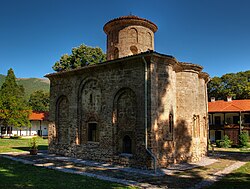Zemen
|
Zemen Земен |
|
|---|---|

The medieval church of the Zemen Monastery
|
|
| Zemen | |
| Coordinates: 42°28′1″N 22°45′0″E / 42.46694°N 22.75000°ECoordinates: 42°28′1″N 22°45′0″E / 42.46694°N 22.75000°E | |
| Country |
|
|
Province (Oblast) |
Pernik |
| Government | |
| • Mayor | Dimitar Sotirov |
| Elevation | 593 m (1,946 ft) |
| Population (2010)[1] | |
| • Total | 1,891 |
| Time zone | EET (UTC+2) |
| • Summer (DST) | EEST (UTC+3) |
| Postal Code | 2440 |
| Area code(s) | 07741 |
Zemen (Bulgarian: Земен) is a town in Pernik Province, western Bulgaria. Located near the Pchelina Reservoir on the banks of the Struma River, it is the administrative centre of Zemen Municipality.
The old name of Zemen was Belovo; it was renamed to Zemen in 1925. The new name was initially only given to the railway station nearby, but it was soon carried over to the village itself. The present name commemorates the medieval castle of Zemlangrad, which was located in the Struma gorge in the vicinity of Zemen. The fortress was first mentioned in the 11th-century Tale of Isaiah as ЗЄМЛЬНЬ ГРАД and as ЗЄМЛЪНЬ in a 15th-16th century Serbian chronicle. The toponym is derived from the Bulgarian word for "land" (земя, zemya) and refers, according to the locals, to the only arable land in the rocky surrounding area.
Proclaimed a town in 1974, Zemen is famous for the medieval Zemen Monastery located on its outskirts. The population of the town is mostly Bulgarian Orthodox.
Zemen Knoll on Livingston Island in the South Shetland Islands, Antarctica is named after Zemen.
...
Wikipedia

